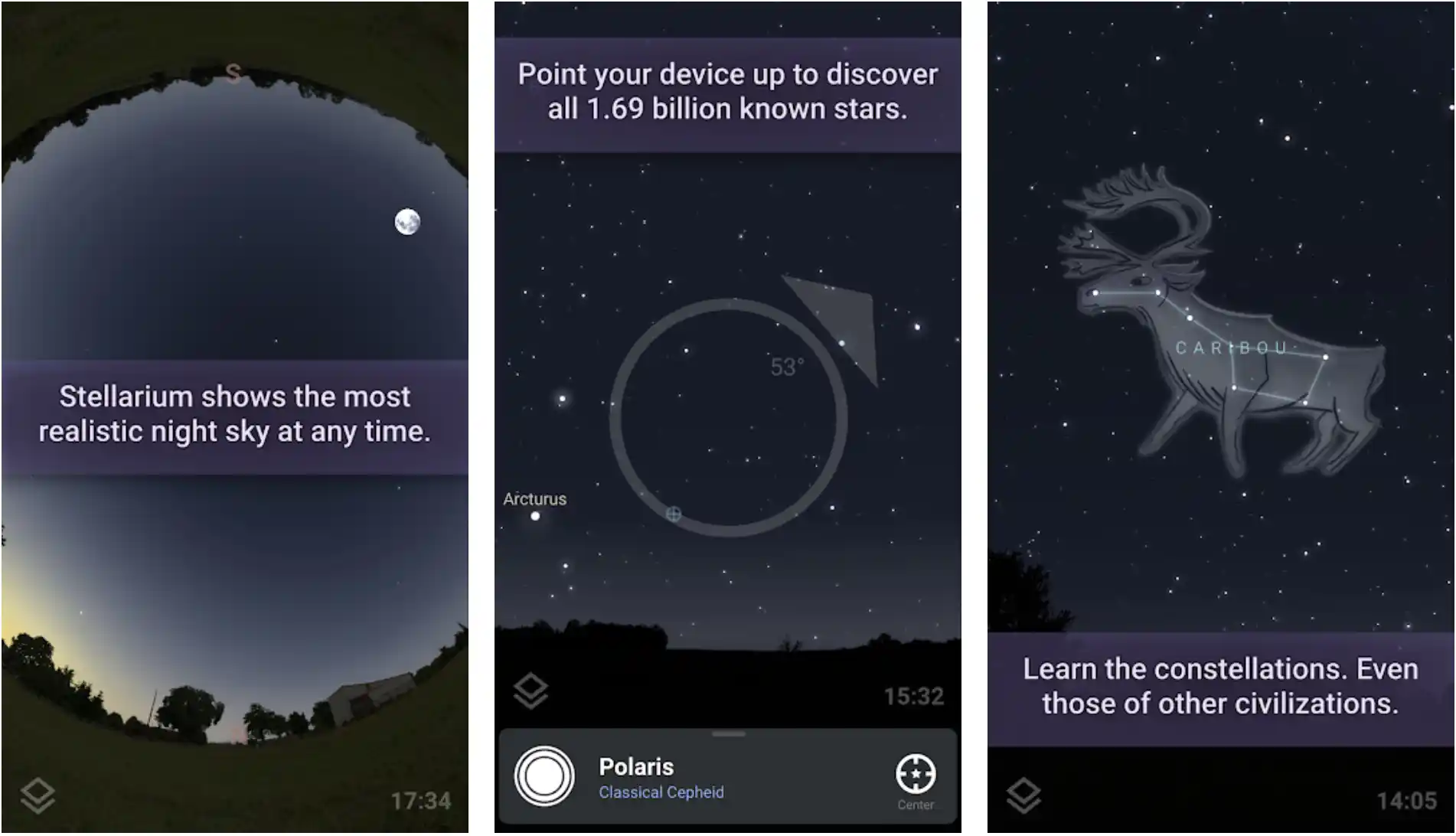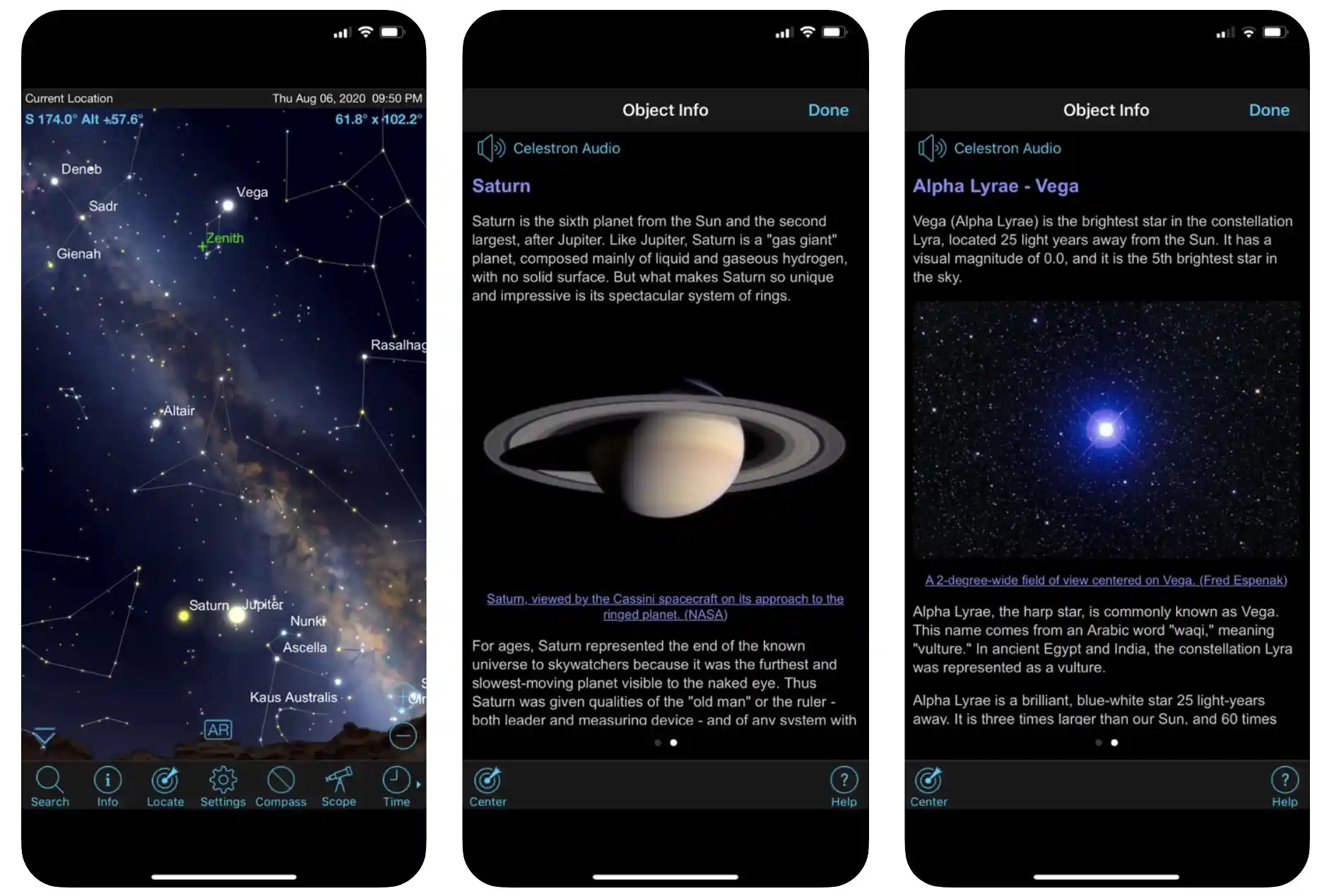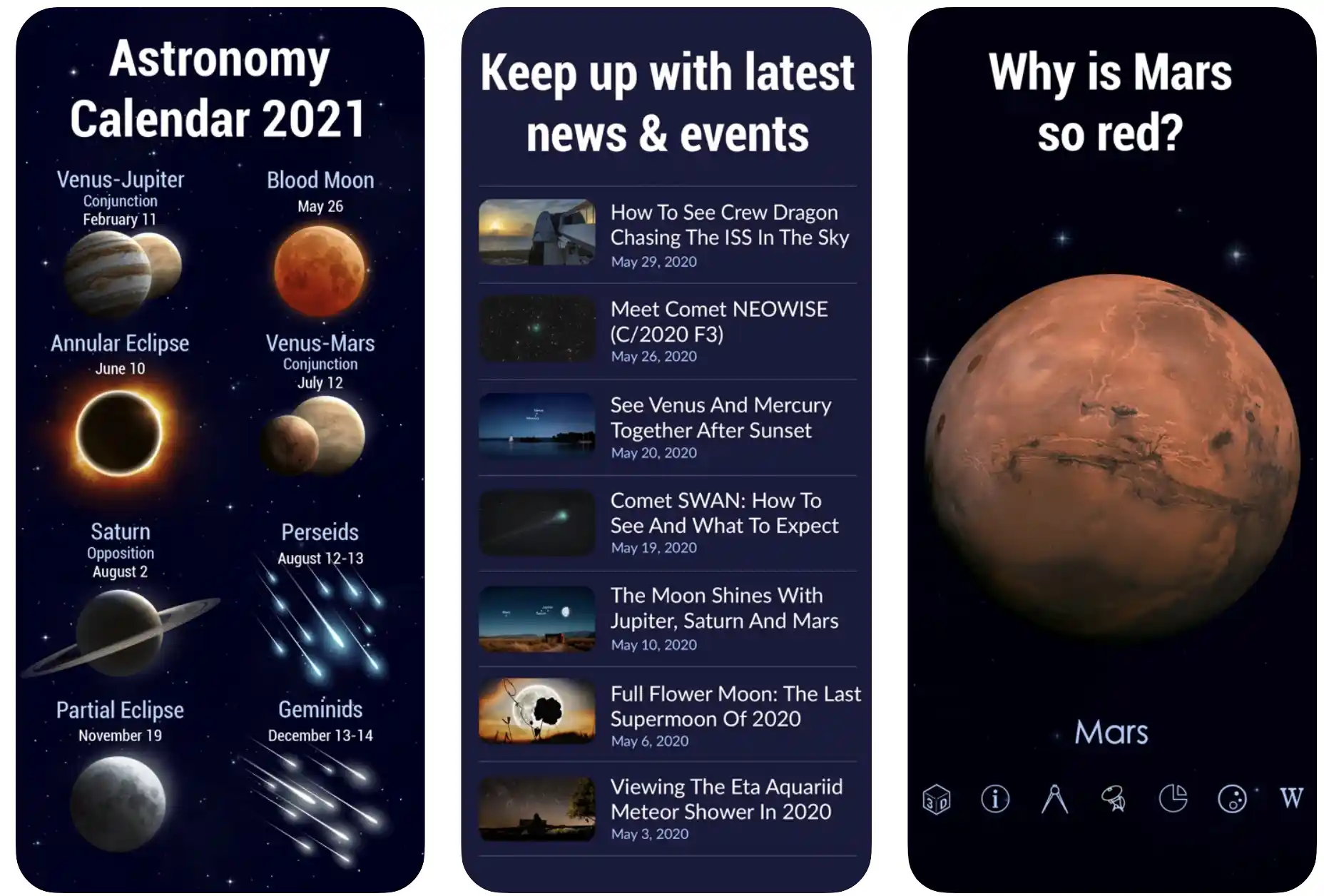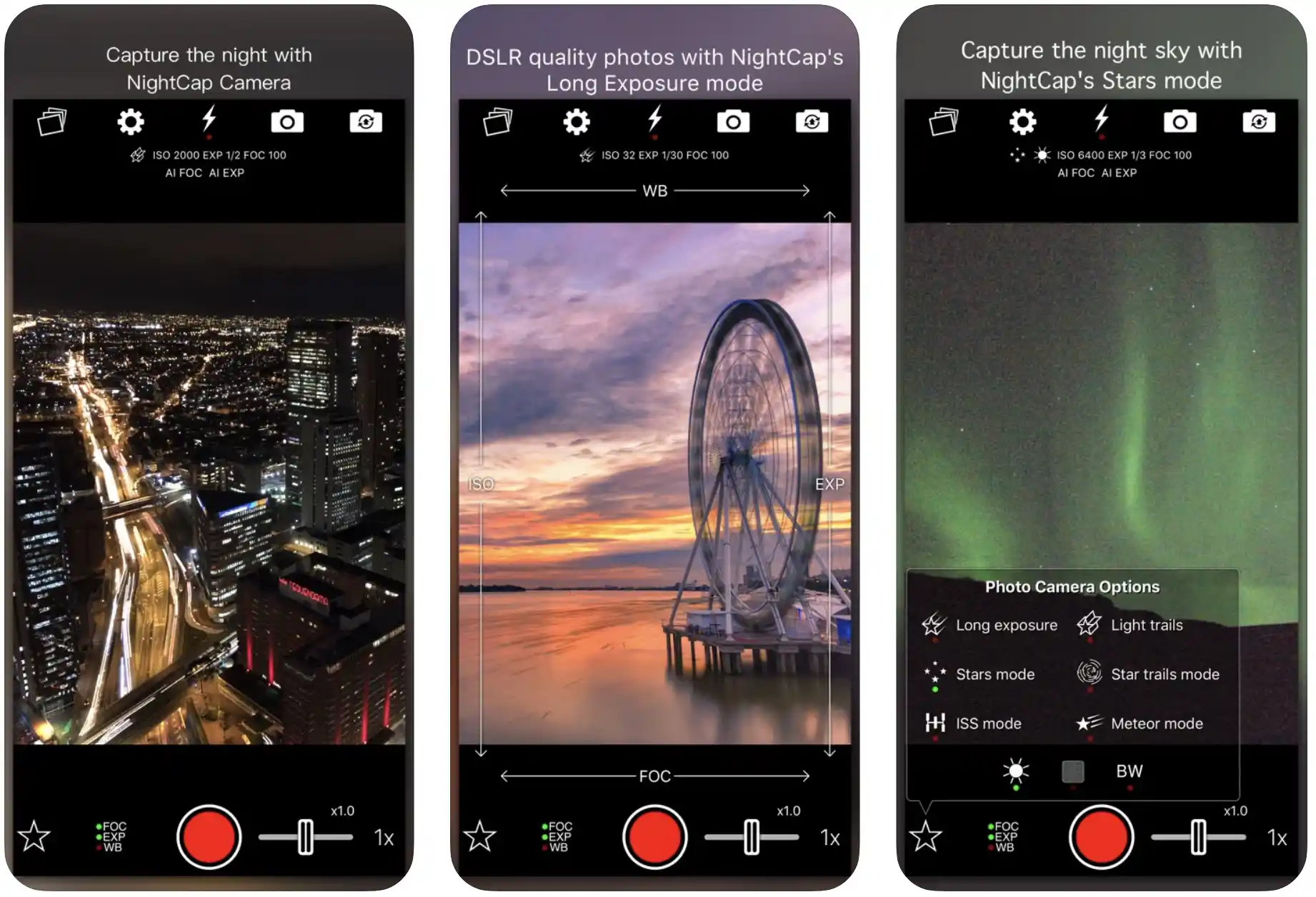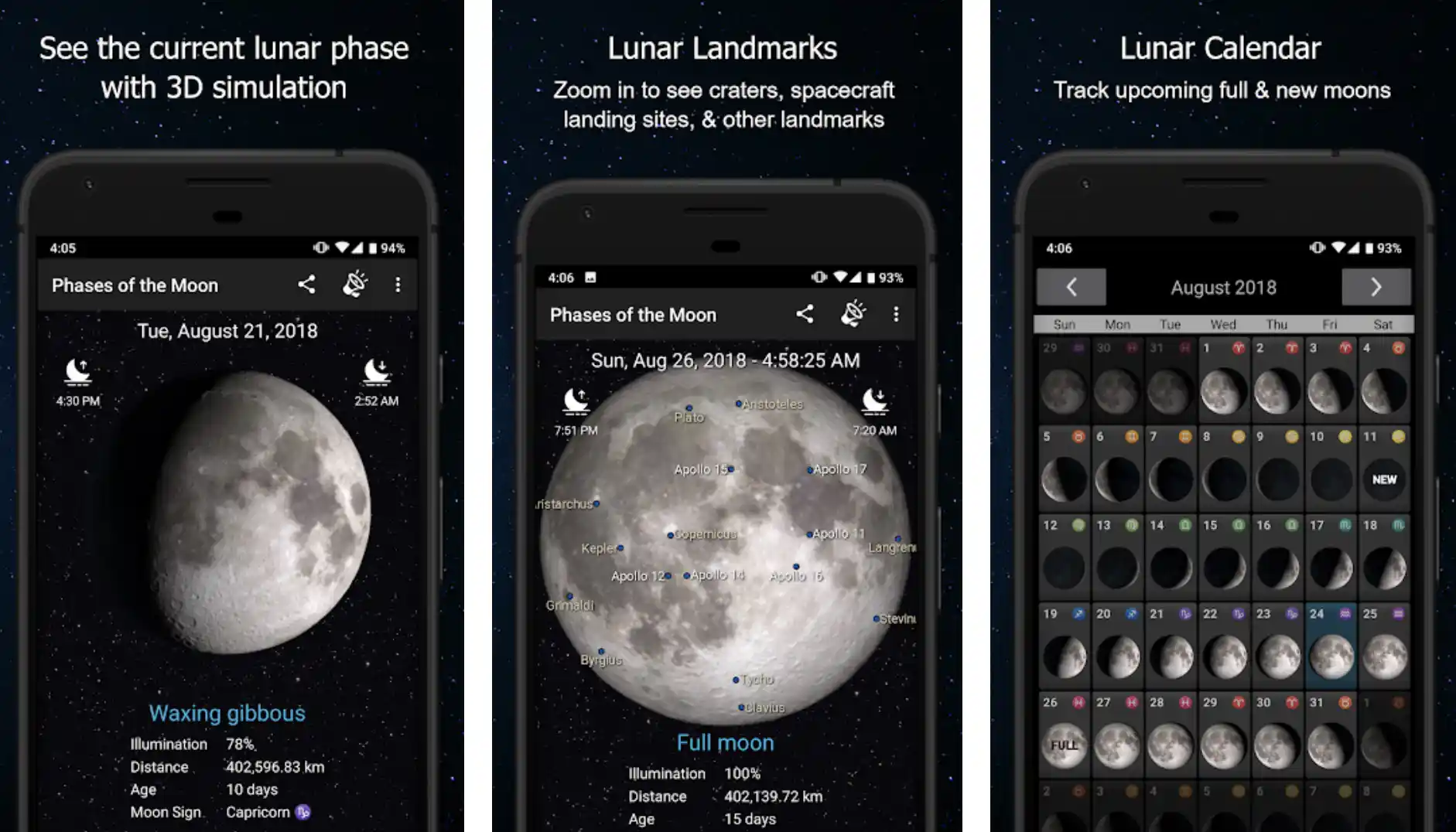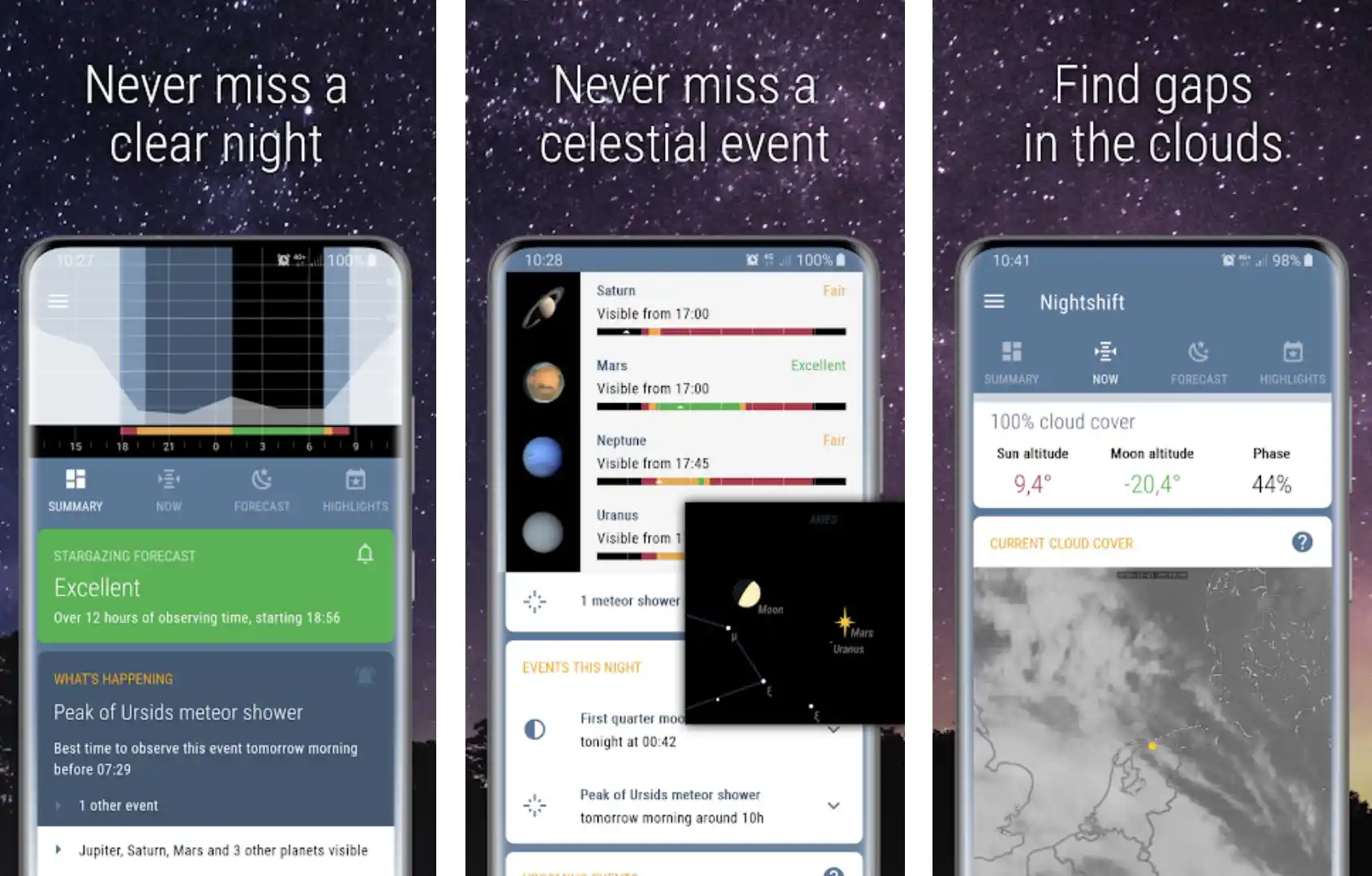Space is a very mysterious place, and if you have curiosity about celestial objects, then you must have heard about the word Astrophotography.
If you haven’t heard about it, this is the perfect place to gather basic knowledge about the best Astrophotography apps and learn more about them.
Astrophotography is known as Astronomical Imaging, capturing images of celestial objects, astronomical phenomena, and the night sky. Mostly these pictures and photographs are not used for scientific research or data.
The main goal is to make aesthetically beautiful pictures pleasing to the eyes. It includes pictures of objects that aren’t visible to the human eye, like nebulae, galaxies, and stars.
Astrophotographers use a variety of unique devices and types of equipment to capture these pictures.
These types of astronomical images are captured uniquely by using extended exposure times.
As we know, celestial objects are very dull, so we must keep the camera shutter open for an extended period to take aesthetically pleasing pictures.
This helps the camera absorb more light and expose more explicit pictures.
What Are Astrophotography Apps?🧐
Two very essential things are required for astrophotography, a reliable camera, and good processing software to back that up.
As you may have already noticed, you can take professional astrophotos only with additional high-grade equipment, as it is much more complicated than taking regular everyday photos.
To capture aesthetically pleasing photos related to astrophotography, you need to develop and acquire a degree of skill as an astronomer.
Astrophotography is challenging and is not just like opening your camera and pressing a click to capture photos.
However, some very good apps for night sky photography can enhance and help you create a taste and a certain skill level to be a professional astrophotographer later.
It is also very important to know that the weather plays a vital role while capturing these pictures and the information about the current whereabouts of the stars or celestial objects. Some of the apps mentioned below are free, while others aren’t.
Mobile apps are evolving daily, and there is a significant increase that we have witnessed in the number of astronomy apps.
So let’s look at the best astrophotography apps on the Internet that you can download today and begin your journey.
This list mentions some of the best-performing apps with good reviews and ratings based on the user experience.
Best Astrophotography Apps – Our Pick👌👌
1. Stellarium – Astrophotography Apps To Discover Known Stars
Stellarium is the first name that pops up when we think about the best Astrophotography apps that help us see celestial objects and stargaze.
It is an open-source software planetarium that is available on every central platform like Mobile, Linux, Windows, and macOS.
It creates an interactive display of a realistic sky in 3D and shows us exactly what we see when we look at the sky and stars.
This app works differently by labeling the objects we see in the night sky at any point in history. It helps you explore the beautiful and mysterious night sky.
In real-time, you can identify constellations, stars, comets, planets, satellites, and numerous other objects. You have to point your device at the sky, and Stellarium will do the rest of the work.
One thing to remember is that Stellarium does not have AR ( Augmented Reality), but it can find deep-space objects. You can even tap on a star or a constellation to gather more information about it.
Stellarium even lets you zoom in for a 360-degree view of the sky. You can even pair it with your telescope, as it is available for Android too.
It has a minimalistic user interface that makes this app easy for every age group, including adults and children.
Download the App from Google Play Store
Download the App from Apple App Store
2. Skyportal
Developed with the association of telescope experts at Celestron and renowned app developers SkySafari, Skyportal is one of the best planetarium apps and telescope control solutions.
If you wish to see the sky and stars differently than usual, you must dig deeper into astronomy.
Skyportal can change your whole perspective of how you look at the sky. It will help you explore celestial objects in-depth with many details about them.
Exploring the sky is the main highlight of this product. It includes the solar system, stars, galaxies, asteroids, comets, satellites, and even our space station.
While exploring, you can listen to the audio descriptions related to the objects or bodies you’re studying. You can also plan your sessions and photos as this app observes your time zone and current location to churn out the best possible results.
If you have a Celestron Telescope compatible with the device using Skyportal, you can control the telescope with the SkyPortal WiFi module.
It is available on iOS as well as Android devices. However, it will only work with the SkyPortal WiFi module sold separately for the telescope control.
To be able to control your telescope with your smartphone is a liability and astonishing if you love exploring the sky.
SkyPortal also shows you a custom list of the top celestial objects based on your current location and time zone.
The most remarkable feature that SkyPortal has is that you can simulate the night sky from up to 100 years back or ahead of the future and even plan your observing session.
You can view a bunch of astronomical photographs taken by NASA. If you’re a good listener and like the podcasts, you can also listen to the audio narration of space’s history, mythology, and science.
Download the App from Google Play Store
Download the App from Apple App Store
3. Astrospheric– Astrophotography apps For Astronomy Weather Forecasting
As you must know, weather plays a very vital role in astrophotography. Good weather is very important for aesthetic images.
If the weather is not good or the sky is cloudy, achieving desired results is next to impossible.
This is why a weather forecast is necessary for astrophotography to specify the weather and the future weather conditions of the venue you’re currently at.
Astrospehric is one of the top-rated weather forecast apps for astrophotographers, astronomers, or explorers. It contains all the vital information about the sky and cloud cover.
Astrospehric collects this astronomical data from reliable sources like the Canadian Meteorological Center, NOAA, and other trusted agencies even if you’re planning for a cloudless sky or sunset.
It produces accurate and to-the-point weather forecasts of the next 48 hours of any geographical location in the continental United States or Canada.
It tells you about overlaying clouds, transparency, and light pollution data on a graphic map, making it very simple and easy to understand the weather for the upcoming two days.
It is updated every 6 hours and provides an extended 8-day cloud forecast. It also provides stats about ground data such as wind, temperature, and humidity, including the sun and moon’s rise and set time.
If you’re specifically curious about the moon, the Astrospheric app can give precise altitude and illumination information to help you make suitable adjustments and decisions.
It will also provide you with a list of upcoming moon phases so you can prepare for those events.
The information provided by this app is easy to understand and comes in color-coded table form. It is free to use and available for Android.
Download the App from Google Play Store
Download the App from Apple App Store
4. SkySafari 6 Pro – Astrophotography Apps Guide To Night Sky
Having SkuSafari 6 Pro installed on your smartphone is like holding a pocket universe in your palms. Simulation Curriculum Corp. created it.
You can use this app to explore the universe, as discussed above.
Just hold your phone upright, and SkySafari will let you know precisely what you’re looking at, at the exact moment. It was designed to be a perfect and complete mobile planetarium.
SkySafari 6 Pro claims that it will revolutionize the astronomical experience of its users. It includes 100 million stars, 3+ million galaxies, and over 770,000+ solar objects, consisting of every comet and asteroid ever discovered by humankind.
It lets you simulate the sky from anywhere on the Earth by giving you insight and visuals of any phenomena that happened or will happen in 1000 years past or the future.
It also lets you identify stars, planets, and constellations with the help of a sky chart. The sky chart follows your motion for better accuracy while viewing and exploring the night sky.
SkySafari also offers educational content for everyone curious, including hundreds of images from NASA space missions, the Hubble telescope, and famous astrophotographers.
Telescope control is also available with the help of SkyFi or SkyWire. The SkySafari plus and pro apps offer this feature for your computer-controlled telescope from anywhere in the sky. It is available for both the Android and iOS platforms. However, it is a paid service.
There are three versions of this app. SkySafari 6 AR is the least expensive one, but it offers a very low database, so exploring might not be as much fun as you expected.
But the other two options, the SkySafari 6 Plus and SkySafari 6 Pro are a little expensive but offer a great immersive experience to their users.
It also has a mind-blowing AR mode.
Download the App from Google Play Store
Download the App from Apple App Store
5. Photopills – Astrophotography apps To Shoot legendary photos
Photopills might be the perfect choice for you if you want to click legendary images. It doesn’t matter what type of photography you love and wants to do.
Photopills will help you click the pictures just like you desire. It lets you unlock your full potential by giving you the right tools. It is a photography planning app.
It assists you with planning your photos way ahead of time so you can always be prepared at the right place at the right time to click the best images possible according to the situation.
Suppose your passion is capturing photos no matter the nature or essence of your pictures.
In that case, Photopills will let you capture Landscapes, the Moon, Sunrise, Sunset, Stars, the Milky Way, Eclipses, Architecture, and whatever you can imagine. The possibilities are limitless.
You can plan any Milky Way shot you’ve imagined on a map. It also has Augmented Reality to help you visualize the Sun, Moon, and Milky Way position and path.
If you’re curious about how this app works, it’s pretty simple. Sometimes, it must’ve happened to you when you walk by a beautiful place and wish there was a Moon or Sun there.
If it were, it would’ve resulted in a great photo. With the help of Photopills, you can calculate the time when the magic moment you wished for will happen.
You think or imagine where you want the Sun, Moon, or Milky Way to be, and you can easily calculate the exact date and time of when it will happen with the help of Photopills.
You can just be there prepared even before the phenomenon occurs, and when it does, you can capture the moments of your dream.
Photopills lets you shoot those legendary pictures and awards you for the sheer determination and hard work you’ve put into clicking that picture.
You can submit your creative photos directly from the and win a cash prize of $6600 and become a legend. , It also has a feature of 3D augmented reality to help you plan the paths of the Sun, Moon, or the Milky Way when you want to scout a potential photo or film time-lapse location.
Overall, this app is unique and has so much potential if you’re going to be an astrophotographer.
Download the App from Google Play Store
Download the App from Apple App Store
6. Star Walk 2: The Night Sky Map
If you love stargazing at night, this is one of the Best Astrophotography Apps built for you.
Star Walk is an astronomy guide that helps you explore and identify stars, constellations, planets, satellites, asteroids, and other celestial bodies that you can think of in real-time in the sky above you.
You have to point your device toward those objects in the sky. Even if you’re a space amateur or an OG stargazer, this app can help you by educating you about astronomy. Teachers can even use this app to teach students about space.
The stars and planets finder shows you the real-time sky map on your device and changes the data as you move your device in a different direction.
A clock-like icon at the top of the right corner allows you to set any date for the past or future, and it will show you the night sky map of stars and planets of that specific date and time.
It also has a feature called AR stargazing. You can view constellations and stars, and planets in augmented reality. It uses your device’s camera to show the charted objects that appear superimposed over live sky objects.
To assist you with that, they also have a star chart app that will give you a deeper understanding of constellations.
You can enjoy the 3D models of constellations, read and learn about their stories, and other fascinating astronomy facts.
It also keeps you updated with the current news about the space. The ‘What’s New’ section will tell you about the astronomical events that have happened or will happen, keeping you updated with the latest news.
However, your device must have a gyroscope sensor and compass to use the Star Spotter feature.
Download the App from Google Play Store
Download the App from Apple App Store
7. The Photographer’s Ephemeris – It’s all about the light
This app is very similar to the Photopills app we discussed earlier in our article. The only difference is that The Photographer’s Ephemeris is an industry-standard for astrophotography planning.
Like the other planning apps, this predicts the Sun, Moon, and Milky Way positions. However, the main area where this app specializes is the geodetic tool.
Photo Ephemeris lets you plan outdoor scenarios for photography in natural light. You can select a position and a topographical situation to capture.
It can help you by giving information about what landscape features will be captured by a given position.
It will help to decide which geographical location and parameters at what dates and times will feature the Sun or the Moon at that particular place. With the help of this app, you can plan and capture your shots with perfect precision.
Professional outdoor photography depends greatly on perfect weather conditions like sunlight and moonlight.
Whatever you’re shooting, whether it is a landscape, architecture, wildlife, etc. This app will tell every detail about the lighting conditions.
You can even plan to capture photos in the future, just set a date that you’re planning to take pictures. This app will tell you about past, present, and future light conditions.
This app is paid, but you can get a 30-day free trial. TPE is also available on the Android platform.
Download the App from Apple App Store
8. Nightcap
Nightcap is an ultimate camera specially designed for low-light photography. It has an AI assistant for better shooting photos, videos, and time-lapse.
Realtime Dreams Limited created this app, and it is solely available on iPhones.
NightCap Camera is a powerful, brilliant app for low-light photography and night shots. You can also create a 4K time-lapse video with the help of this app.
Long exposure shots are preferred for low light imaging as they produce beautiful images in low light, and this app also has a feature called Astronomy mode that captures the stars, Aurora(Northern Lights), and much more.
Apart from all these features, NightCap also offers dedicated features like Star Trails, ISS, and shooting stars type of photography.
As for compatibility, NightCap is available for all iOS devices like iPhones, iPads, and Apple watches.
Download the App from Apple App Store
9. The Moon- Phases Calendar
To give you a basic idea about the phases of the Moon, there are four primary moon phases: New Moon, First Quarter, Full Moon, and Last Quarter.
This app does exactly what its name suggests about it. This contains the universal lunar calendar for any location from 0001AD to 2100 years.
Our lunar calendar is one of the most ancient calendars, as you must know that a lunar month can be 29 to 30 days long.
With the help of this app, you can set a specific reminder for any moon event to choose your day/time.
This app contains all the data, including the moonrise time, moonset time, illumination level, and distance to the moon.
It even provides a monthly calendar of how the moon will change its shape according to time.
You can also track all the cycles of the Moon, including all its phases, through the live moon wallpapers that are available on this app.
You can also view the current lunar phase with the help of a 3D simulation made by NASA data.
It reminds you of every major moon event during the month. It is available for both Android and iOS platforms.
Download the App from Google Play Store
While exploring the 11 Best Astrophotography Apps for experienced and novice astronomy lovers, I found an awesome video on “All the Planets from Inside in 3D,” worth watching.😍😎
10. Nightshift – Astrophotography apps To Never Miss a Clear Night
If you have a passion and love for astronomy and stargazing, then Nightshift is a one-time stop. Nightshift helps you find the perfect time and night for stargazing.
You can find something interesting in this app even if you’re a professional or a genuine star lover.
If you’re in love and looking for a date under the stars or want to click some pictures with your telescope, you can find the best possible time to capture those pictures with the help of the Nightshift app.
Nightshift even notifies you of the best conditions if you’re worried about poor visibility when exploring the night sky. It also keeps you updated about the current celestial events in the night sky.
It even forecasts clouds and darkness for any location on Earth, so you can earn a reasonable opportunity to stargaze.
While viewing with the help of sky view, you can zoom in to discover and explore the tiniest or faintest of objects and activate Gerald circles to locate and mark your favorite places as targets at your telescope.
It also has an event calendar that tells you exactly when the next opposition of Saturn, Jupiter, Uranus, and Neptune will happen so that you can plan your observing sessions ahead of time, leading to a better exploring experience.
Apart from all those features, Nightshift also has Moon phases and a lunar eclipse calendar, so you don’t miss out on any significant event.
It has very in-depth information about all the celestial bodies, which includes their type classification, brightness, angular size, distance, and cross-reference with other astronomy catalogs.
It can also be used as an educational resource for amateurs.
Download the App from Google Play Store
📗FAQ on Astrophotography Apps📗
What is the best free Astronomy app?
One of the best free astronomy apps is Stellarium. It provides a 3D night sky simulation and allows users to explore and identify celestial objects, including stars, planets, and constellations.
Is there an app for finding the Milky Way galaxy?
Several apps can help locate the Milky Way galaxy, including PhotoPills and Sky Guide. These apps use your location and time of day to provide an accurate view of the night sky, and can help you identify where the Milky Way is.
What is the best app for taking pictures of stars?
There are many great apps for taking pictures of stars, but one of the best is Camera FV-5. This app allows you to adjust settings like ISO, exposure, and focus, giving you more control over your photos.
Can you do astrophotography with a phone?
Yes, you can do astrophotography with a phone. Many smartphones have powerful cameras and manual controls that can take stunning night sky photos.
What app can I use to see stars and galaxies?
One app that you can use to see stars and galaxies is SkySafari. This app provides a detailed night sky view and includes information on celestial objects like stars, planets, and galaxies.
Is the Sky app free?
Some sky apps are free, while others require a purchase or subscription. However, many free sky apps are available that provide a basic view of the night sky.
How do you find the Milky Way in the night sky?
To find the Milky Way in the night sky, look for a faint band of light that stretches across the sky. The Milky Way is visible from many locations on Earth, but it is easiest to see in areas with little light pollution.
In what direction do I look to see Milky Way?
The direction to see the Milky Way depends on your location and the time of year. However, the Milky Way is generally visible in the southern part of the sky during the summer months in the Northern Hemisphere.
How can I use my smartphone for astrophotography?
To use your smartphone for astrophotography, you can download an app that provides manual controls for settings like ISO, exposure, and focus. You can also use a tripod or stabilizer to keep your phone steady while taking long exposure shots.
How do you take detailed pictures of stars?
To take detailed pictures of stars, you will need a camera with manual controls and a tripod to keep the camera steady during long exposures. You can also adjust settings like ISO and aperture to capture more detail in your photos.
How do you capture astrophotography?
To capture astrophotography, you will need a camera with manual controls and a tripod to keep the camera steady during long exposures. You can also use a remote shutter release or timer to prevent camera shake and blur.
Can you do astrophotography without a star tracker?
Yes, you can do astrophotography without a star tracker. However, using a star tracker can help improve the quality of your photos by reducing star trails and allowing for longer exposure times.
What is the best cell phone for astrophotography?
Some of the best cell phones for astrophotography include the iPhone 12 Pro Max, Google Pixel 5, and Samsung Galaxy S21 Ultra. These phones have powerful cameras and manual controls that allow for high-quality night sky photos.
How do I capture the Milky Way with my phone?
To capture the Milky Way with your phone, you must use a tripod or stabilizer to keep your phone steady during long exposures.
You can also adjust settings like ISO, and exposure and focus on capturing more detail in your photos. You may also need to use a specialized app to manually adjust camera settings unavailable in the phone’s default camera app.
What app has the most stars?
Several apps offer a comprehensive night sky view, with detailed information on stars, constellations, and other celestial objects. One such app is Star Chart, which offers a 360-degree night sky view and includes over 120,000 stars.
How accurate is Skyview app?
Skyview is a highly accurate app that provides a real-time view of the night sky, based on your location and the current time.
The app uses advanced algorithms to accurately identify and label celestial objects like stars, planets, and constellations.
Is SkySafari app free?
SkySafari is a premium app that requires a purchase or subscription to access its features. However, a free version of the app is available, which provides a basic view of the night sky and information on celestial objects.
Do people still pay for sky?
Many still pay for access to premium sky apps and services that offer advanced features and more detailed information on the night sky. These services may include live views from telescopes, detailed sky maps, and other tools for exploring the cosmos.
Can you use Sky apps without a subscription?
Some sky apps offer a free version that provides basic information on the night sky, while others require a subscription or purchase to access all their features. However, even with the free version of many sky apps, you can still use them to explore the night sky and learn about celestial objects.
Which devices have a Sky app?
Sky apps are available on various devices, including smartphones, tablets, and computers. Some popular sky apps are available for both iOS and Android devices, while others are specific to one platform or the other.
How do I turn my phone into a telescope?
To turn your phone into a telescope, you can use a specialized smartphone adapter that attaches to the eyepiece of a telescope. This adapter allows you to align your phone’s camera with the telescope’s eyepiece, giving you a close-up view of celestial objects.
Is there an app to see the universe?
Several apps allow you to explore the universe, including NASA’s official app, which provides news, videos, and images of space missions and celestial objects.
Other apps, like Star Chart and SkySafari, provide a comprehensive view of the night sky and information on celestial objects.
How much does the app Night Sky cost?
Night Sky is a premium app that requires a purchase or subscription to access all of its features. However, a free version of the app is available, which provides a basic view of the night sky and information on celestial objects.
Can you see the Milky Way with the naked eye?
Yes, it is possible to see the Milky Way with the naked eye from areas with low light pollution. The Milky Way appears as a faint band of light that stretches across the night sky, and is easiest to see during the summer months in the Northern Hemisphere.
What time of night is the Milky Way most visible?
The Milky Way is most visible during the summer months in the Northern Hemisphere, and is typically best seen after midnight when it is higher in the sky. However, the best time to view the Milky Way can vary depending on location and local weather conditions.
What is the darkest time of night tonight?
The darkest time of night varies depending on your location and the time of year. However, the darkest time of night is typically a few hours before sunrise.
What time is best for astrophotography?
The best time for astrophotography is typical during the early evening or late at night when the sky is darkest. This is when you can capture the most detail in your photos and when the Milky Way and other celestial objects are most visible.
However, the exact time best for astrophotography can vary depending on your location, the time of year, and other factors like weather conditions and moon phase.
In what states can you see the Milky Way?
The Milky Way is visible from many states in the United States, but the best views are typically found in areas with low light pollution.
Some of the best states for viewing the Milky Way include Arizona, Utah, and Wyoming, with many national parks and other protected areas with dark skies.
Why can’t I see the Milky Way at night?
If you can’t see the Milky Way at night, it may be due to high levels of light pollution in your area. Light pollution from streetlights, buildings, and other sources can make it difficult to see faint objects like the Milky Way.
To improve your chances of seeing the Milky Way, visit a location with low light pollution, like a national park or another rural area.
What phone is best for capturing the Milky Way?
Some of the best phones for capturing the Milky Way include the iPhone 12 Pro Max, Samsung Galaxy S21 Ultra, and Google Pixel 5. These phones have powerful cameras with manual controls and other features that make them well-suited for astrophotography.
What is the 500 rule astrophotography smartphone?
The 500 rule is used in astrophotography to determine the maximum exposure time for capturing stars without causing motion blur.
To use the 500 rule with a smartphone camera, you divide 500 by the lens’s focal length. This will give you the maximum exposure time in seconds before star trailing occurs.
How do I use my smartphone adapter as a telescope?
To use a smartphone adapter as a telescope, attach the adapter to your telescope’s eyepiece and then align your phone’s camera with the eyepiece.
Once your phone is aligned, you can capture images or videos of the celestial objects you view through your telescope.
Why are my star photos blurry?
Star photos can be blurry for several reasons, including camera shake, poor focus, and motion blur caused by long exposure times. To reduce camera shake, use a tripod or other stabilizer.
Use manual focus or tap on the object you want to focus on to improve focus. And to reduce motion blur, use a shorter exposure time or a star tracker.
What is the best focal length for the night sky?
The best focal length for night sky photography can vary depending on the type of photo you want to capture.
However, in general, a wide-angle lens with a focal length between 14mm and 24mm is well-suited for capturing night sky images, including the Milky Way and other celestial objects.
How do I start astrophotography for beginners?
To start astrophotography as a beginner, you will need a camera with manual controls, a tripod, and a remote shutter release or timer.
Start by experimenting with different camera settings and exposure times to capture night sky images. You can also use specialized apps or software to help you identify and track celestial objects.
What is the easiest astrophotography?
The easiest astrophotography is typically wide-angle photography, which involves capturing images of large areas of the night sky, such as the Milky Way or a starry landscape. Wide-angle photography requires less specialized equipment and can be done with a basic camera and tripod.
Is astrophotography tool free?
Astrophotography tools range from free to paid software and apps, depending on their features and functionality.
Some basic tools like photo editors and star maps are free, while more advanced tools like image stacking software or astrophotography planning apps may require a purchase or subscription.
Can you do astrophotography with a normal camera?
You can do astrophotography with a normal camera if it has manual controls and can take long exposures. However, cameras with larger sensors and wider aperture lenses may be better suited for capturing more detail in your photos.
What is the best and cheapest camera for astrophotography?
The best cheapest camera for astrophotography is the Canon EOS Rebel T7. This camera has a large sensor and manual controls, making it well-suited for capturing night sky images. It is also relatively affordable compared to other cameras with similar features.
Can any phones photograph the night sky?
Most modern smartphones are capable of capturing images of the night sky. However, some phones are better suited for astrophotography, with features like manual controls and larger sensors to help produce higher-quality images.
Is 35mm or 50mm better for astrophotography?
Both 35mm and 50mm lenses can be used for astrophotography, but they offer different advantages. A 35mm lens has a wider field of view, making it well-suited for capturing larger objects like the Milky Way.
A 50mm lens has a narrower field of view but can capture more detail in individual objects like stars.
Why can’t i photograph the Milky Way?
If you are having trouble photographing the Milky Way, it may be due to factors like light pollution, poor weather conditions, or camera settings not optimized for astrophotography.
To improve your chances of capturing a good photo of the Milky Way, try finding a dark location with low light pollution and experiment with different camera settings and exposure times.
What app is used for astrophotography?
Stellarium – Star Map, Skyportal, SkySafari 6 Pro, Star Walk 2, and Nightcap, etc. are some of the most popular applications used for astrophotography and offer a wide range of features like the most realistic night sky photos, lessons on constellations, astronomy weather forecasting, augmented reality related to the astronomical world, time-lapse location and more.
Can you do astrophotography with a smartphone?
Astrophotography using a smartphone can be a hit as well as a miss. However, with a little practice, it is more than just possible to get multiple polished images that are at least good enough to share on social media.
You can try using easily available astrophotography applications like Star Walk 2, Photopills, Nightcap, The Photographer’s Ephemeris, Nightshift, Skyportal, etc.
What is the best app to use with a telescope?
Stellarium, Skyportal, SkySafari 6 Pro, Nightcap, The Moon, etc. are among the best applications to use with a telescope and are powerful enough to transform the way you have been involved in astrophotography.
Is there a free astronomy app?
SkyView Free is one of the most popular, beautiful, and highly intuitive astronomy applications.
It enhances the ability of your camera to precisely spot and identifies a wide range of celestial objects in the sky, day or night. Other applications you can try are Sky Map, SkySafari, Nightshift, Sky View Lite, etc.
Conclusion on best apps for astrophotography
In this article, we’ve discussed the best astrophotography apps that can help with your journey on space exploration. We hope that you found what you were looking for.
Some of the apps mentioned here are very different and serve different purposes. You can choose an app that fulfills your needs and purpose.
The best astrophotography app is one that works on your operating system flawlessly. If you want to take pictures of stars or celestial bodies, you must have access to a telescope and perfect weather conditions. Many apps here give details and predict the right weather for astrophotography.
Even if you’re not successful the first time while taking pictures, don’t worry; there will be plenty of opportunities. Until then, you can just look up into the sky and admire the beauty of the sky through the help of astronomical apps on the mobile planetarium.
These apps are great for amateurs, too, as it provides a plethora of detailed information about major celestial bodies and objects. The theory is also essential to know what you’re looking at. The selection of apps depends on you.
All of the apps mentioned above aren’t free, some of them are paid, but they do their job as promised.
Astrophotography is a field that needs hard work, dedication, patience, and constant determination if you want to succeed in this field.
Most of the time, you must go out of town to capture images worth the effort. However, suppose you’re not a professional and just looking at the sky due to sheer curiosity.
In that case, most of the apps mentioned above can be very useful to you as they have all the information you need to calm your curiosity.
I hope you achieve everything you deserve—best of luck with your future adventures. Keep hustling and exploring. Space is beautiful, and so are you.

























